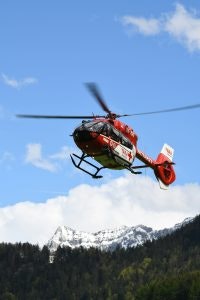Traveling abroad, especially with teens, comes with its share of risks. At Rustic Pathways, we take student safety seriously, preparing for emergencies before they ever occur. Through realistic crisis simulations and extensive training, our team is ready to handle any situation that may arise during a trip.
From medical emergencies to unforeseen disasters, our goal is to ensure that students are supported every step of the way. In this article, we’ll walk you through how we manage travel emergencies, the steps we take when crises happen, and how our team’s readiness ensures that students return home safely after their adventures.
Crisis Simulations for Safety Preparation
My phone rang with news of an accident in Peru: “One of our groups got caught in a landslide, and people are trapped in a truck!” As I processed this, a message appeared on Skype: “For the next three hours, we will be running a crisis simulation.”

Emergency rescue helicopter in Austria
The moment of panic was brief as I shifted into action. At Rustic Pathways, safety is our priority, so we conduct practice scenarios to be prepared for any disaster. Our goal is to ensure we know exactly what to do in a real crisis.
For three hours, I received calls from actors portraying concerned parents, students, and staff. We treated the landslide incident as real, engaging our Crisis Response Team, including our CEO, directors, managers, Country Management teams, and Program Leaders. We split the team to manage parent communication and address the needs of “injured” students.
The actors played their roles intensely, making the situation feel real. Program Leaders, certified Wilderness First Responders, took charge on the ground, stabilizing the situation and dispatching an ambulance. We kept parents updated, then debriefed afterward to identify what worked and what could be improved.
At Rustic Pathways, we prioritize student safety by running realistic crisis simulations to ensure our team is always ready to handle medical emergencies and other critical situations effectively.
| Topic | Details |
|---|---|
| Objective of Simulations | The goal is to train the team to handle emergencies properly, including medical emergencies, using proper medical equipment and procedures. |
| How the Simulations Work |
|
| Who Is Involved |
|
| Post-Simulation Review | After the simulation, the team discusses what went well and what could be improved, considering factors like access to medical care, emergency services, and flight arrangements if necessary. |
Real-Life Crisis Management in Thailand
Just a few weeks later, during the summer travel season, a student fell ill in Thailand. The student complained of severe stomach pain while on a trip to a remote village hours from the nearest medical care. Our Program Leaders quickly realized this wasn’t a typical stomach bug, and they knew that immediate action was required.
 The Country Management Team swung into action, organizing an evacuation and arranging for the student to be taken to the nearest hospital. We notified the student’s parents within hours.
The Country Management Team swung into action, organizing an evacuation and arranging for the student to be taken to the nearest hospital. We notified the student’s parents within hours.
Doctors confirmed the student needed an emergency appendectomy. We immediately activated our Crisis Response Team and coordinated with our medical, security, and travel assistance partners to ensure the hospital had everything needed for the procedure.
Program Leaders and Country Team members stayed with the student, providing support until the parents arrived. By the time the parents reached Thailand, the student had undergone surgery and was already on the road to recovery.
| Topic | Details |
|---|---|
| What Happened | A student developed severe stomach pain while in a remote area, requiring medical treatment. The situation was complicated by the student being far from a hospital or emergency services. |
| Response Actions |
|
| Medical Outcome | The student needed emergency surgery (appendectomy), and the flight crew on the medical transport assisted with the journey to the hospital. |
| Support Coordination |
|
| Outcome | The student had successful surgery, with medical personnel providing care and treatment. The parents arrived safely the next day. |
Importance of safety in Teen Travel Programs
Ensuring the safety of students during their travels is a fundamental priority for Rustic Pathways. Through continuous training, regular crisis simulations, and coordination with emergency services, we provide students with a safe travel experience across the world.
| Topic | Details |
|---|---|
| Focus on Safety | Keeping students safe is a top priority for Rustic Pathways, including making sure they have proper health insurance, medical assistance, and access to emergency services. |
| How We Prepare |
|
| Impact of Training | Practice helps the team handle real emergencies effectively, from managing a heart attack to coordinating medical assistance and emergency evacuation. |
| Outcome for Students | Over 5,000 students traveled safely, thanks to thorough safety measures, health insurance, medical equipment, and well-prepared flight crews and emergency services. |
For more information about how Rustic Pathways ensures the health and safety of your teen, please visit the Health and Safety page on our website.
